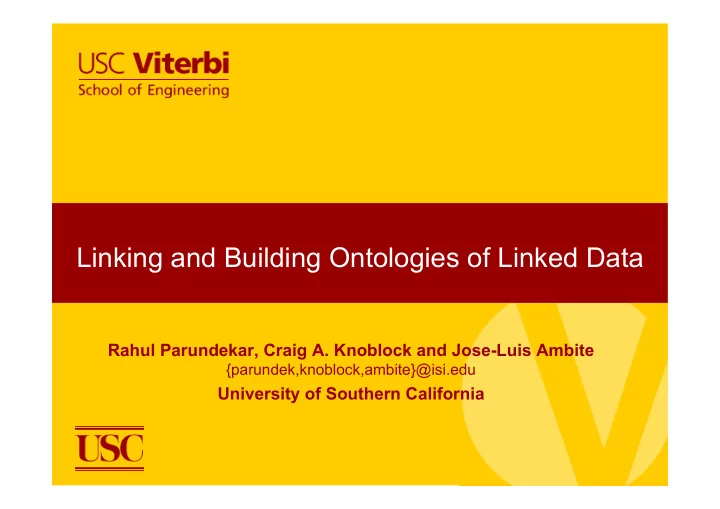

Linking and Building Ontologies of Linked Data Rahul Parundekar, Craig A. Knoblock and Jose-Luis Ambite {parundek,knoblock,ambite}@isi.edu University of Southern California
Web of Linked Data • Vast collection of interlinked information • Different sources with different schemas
Web of Linked Data • Interlinked instances in the various domains • Equivalent instances linked with owl:sameAs Geospatial Domain
Interlinked Instances Source 1 Source 2 Schema Level PopulatedPlac City e Instance Level owl:sameAs City of Los Los Angeles Angeles
Disjoint Schemas Source 1 Source 2 Schema Level PopulatedPlac NO LINKS!! City e Instance Level owl:sameAs City of Los Los Angeles Angeles
Objective 1: Find Schema Alignments Source 1 Source 2 Schema Level = PopulatedPlac City e Instance Level owl:sameAs City of Los Los Angeles Angeles
Ontologies of Linked Data • Ontologies can be highly specialized • e.g. DBpedia has classes for Educational Institutions, Bridges, Airports, etc. • But some can be rudimentary • e.g. in Geonames all instances only belong to a single class – ‘Feature’ • Derived from RDBMS schemas from which Linked Data was generated
Traditional Alignments • There might not exist exact equivalences between classes in two sources • Only subset relations possible Geonames DBpedia Schema Level ⊃ Educational Feature Institution Instance Level owl:sameAs University of University of Southern California Southern California
Restriction Classes • A specialized class can be created by restricting the value of one or more properties • The following Venn diagram explains a restriction class in Geonames with a restriction on the value of the featureCode property as ‘S.SCH’ Set of all instances in Set of all instances in Restricted Class - Original Class - rdf:type =Feature & rdf:type =Feature featureCode =S.SCH
Objective 2: Find Alignments Between Restriction Classes • Find and model specialized descriptions of classes Geonames DBpedia Schema Level = rdf:type =Feature & rdf:type =Educational featureCode =S.SCH Institution Instance Level owl:sameAs University of Southern University of Southern California California
Domains • Geospatial • Dbpedia • LinkedGeoData • Geonames • Zoology • Geospecies • Dbpedia • Genetics (Bio2RDF) • GeneID • MGI
Approach • Aligning Restriction Classes R 1 R 2
Approach • Aligning Restriction Classes ? R 1 R 2 • Find relation between the two restriction classes • Equivalent • Subset
Extensional Approach to Ontology Alignment
Lattice of Restriction Classes • Instances belonging to a restriction class also belong to parent restriction class • e.g. restrictions from Geonames below • This also results in a hierarchy in the alignments, which our algorithm exploits
Exploration of Hypotheses Search Space (LinkedGeoData with DBpedia) Seed hypotheses generation (lgd:gnis%3AST_alpha=NJ) (rdf:type=lgd:country) (dbpedia:Place#type= (rdf:type=owl:Thing) h>p://dbpedia.org/resource/City_(New_Jersey)) Seed hypothesis pruning (owl:Thing covers all instances) (rdf:type=lgd:node) (rdf:type=lgd:node) (rdf:type=lgd:node) (rdf:type=dbpedia:BodyOfWater) (rdf:type=dbpedia:PopulatedPlace) (dbpedia:Place#type=dbpedia:City) (rdf:type=lgd:node) (dbpedia:Place#type=dbpedia:City & rdf:type=owl:Thing) Prune as no change in the extension set (rdf:type=lgd:node) (rdf:type=dbpedia:BodyOfWater & dbpedia:Place#type=dbpedia:City) Pruning on empty set (rdf:type=lgd:node) r 2 = Ø (rdf:type=dbpedia:PopulatedPlace & dbpedia:Place#type=dbpedia:City)
1. Prune seed hypothesis if either restriction covers all instances in that source Seed hypotheses generation (lgd:gnis%3AST_alpha=NJ) (rdf:type=lgd:country) (dbpedia:Place#type= (rdf:type=owl:Thing) h>p://dbpedia.org/resource/City_(New_Jersey)) 1 Seed hypothesis pruning (owl:Thing covers all instances) (rdf:type=lgd:node) (rdf:type=lgd:node) (rdf:type=lgd:node) (rdf:type=dbpedia:BodyOfWater) (rdf:type=dbpedia:PopulatedPlace) (dbpedia:Place#type=dbpedia:City) (rdf:type=lgd:node) (dbpedia:Place#type=dbpedia:City & rdf:type=owl:Thing) Prune as no change in the extension set (rdf:type=lgd:node) (rdf:type=dbpedia:BodyOfWater & dbpedia:Place#type=dbpedia:City) Pruning on empty set (rdf:type=lgd:node) r 2 = Ø (rdf:type=dbpedia:PopulatedPlace & dbpedia:Place#type=dbpedia:City)
2. Number of instance pairs supporting hypothesis must be above a threshold Seed hypotheses generation (lgd:gnis%3AST_alpha=NJ) (rdf:type=lgd:country) (dbpedia:Place#type= (rdf:type=owl:Thing) h>p://dbpedia.org/resource/City_(New_Jersey)) Seed hypothesis pruning (owl:Thing covers all instances) (rdf:type=lgd:node) (rdf:type=lgd:node) (rdf:type=lgd:node) (rdf:type=dbpedia:BodyOfWater) (rdf:type=dbpedia:PopulatedPlace) (dbpedia:Place#type=dbpedia:City) (rdf:type=lgd:node) (dbpedia:Place#type=dbpedia:City & rdf:type=owl:Thing) Prune as no change in the extension set 2 (rdf:type=lgd:node) (rdf:type=dbpedia:BodyOfWater & dbpedia:Place#type=dbpedia:City) Pruning on empty set (rdf:type=lgd:node) r 2 = Ø (rdf:type=dbpedia:PopulatedPlace & dbpedia:Place#type=dbpedia:City)
3. Prune if the added constraint does not change the extension Seed hypotheses generation (lgd:gnis%3AST_alpha=NJ) (rdf:type=lgd:country) (dbpedia:Place#type= (rdf:type=owl:Thing) h>p://dbpedia.org/resource/City_(New_Jersey)) Seed hypothesis pruning (owl:Thing covers all instances) (rdf:type=lgd:node) (rdf:type=lgd:node) (rdf:type=lgd:node) (rdf:type=dbpedia:BodyOfWater) (rdf:type=dbpedia:PopulatedPlace) (dbpedia:Place#type=dbpedia:City) 3 (rdf:type=lgd:node) (dbpedia:Place#type=dbpedia:City & rdf:type=owl:Thing) Prune as no change in the extension set (rdf:type=lgd:node) (rdf:type=dbpedia:BodyOfWater & dbpedia:Place#type=dbpedia:City) Pruning on empty set (rdf:type=lgd:node) r 2 = Ø (rdf:type=dbpedia:PopulatedPlace & dbpedia:Place#type=dbpedia:City)
4. Lexicographic ordering Lexicographic ordering provides a systematic search by pruning hypotheses with reverse order r 1 (p 5 =v 5 ) Hypothesis (p 8 =v 8 ) r 2 (p 5 =v 5 & p 6 =v 6 ) (p 5 =v 5 & p 7 =v 7 ) (p 8 =v 8 ) (p 8 =v 8 ) Prune 4 (p 5 =v 5 & p 6 =v 6 & p 7 =v 7 ) (p 8 =v 8 )
Relaxed Scoring • Compensates for missing, inconsistent in the data
Post-processing: Removing Implied Alignments Keep the simpler definition & Remove the implied definition
Removing Implied Alignments r 1 r 2 r’ 1 r’ 2 Cascading
Results: Geospatial Domain
Results: Zoology Domain
Results: Genetics Domain
Results: Alignments Found • Equivalences, Subset alignments before and after removing implied alignments
Datasets: http://www.isi.edu/integration/data/LinkedData
Related Work • Euzenat et al. – Ontology Matching Terminological • Structural • Semantic • • FCA-Merge, Duckham et al. Use extensional techniques • • GLUE Uses an extensional technique after performing machine learning • operations
Conclusion • Our algorithm generates alignments, consisting of conjunctions of restriction classes • Extensional approach on Linked Data • Use of restriction classes • Alignments based on the actual data • We determine the relationships based on the data • Schemas of linked sources can be readily modeled and used • Algorithm also able to • Specialize ontologies where original were rudimentary • Find complimentary hierarchy across an ontology
Future Work • How to actually understand these alignments • Scalability • Pre-procesing of the sources • Faster alignment processing
Recommend
More recommend